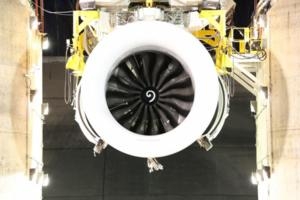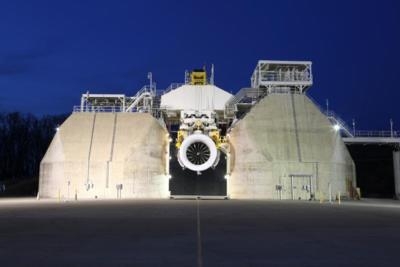Wed, Apr 13, 2016
Ground Runs Underway At GE Peebles Facility In OH
Ground testing in underway on the first full GE9X development engine, which is the world's largest commercial aircraft engine, at GE Aviation's Peebles Testing Operation in Ohio. The GE9X engine will power Boeing's new 777X aircraft.

"The entire GE9X team-from engineering to sourcing to supply chain to development assembly-devoted countless hours to enable this achievement to occur," said Bill Millhaem, general manager of the GE90/GE9X engine programs at GE Aviation. "The ground testing will generate data on the full engine system and aerodynamic performance, mechanical verification, and aero thermal system validation."
"We would like to convey our congratulations to the GE team for its achievement of this milestone," said Bob Feldmann, Boeing 777X vice president and general manager. "GE's commitment to technology maturation throughout the GE9X development program continues to deliver results for the 777X program. We look forward to working together with GE to deliver this great airplane to our customers."
Maturation testing of the GE9X engine began about five years ago and has progressed from component-level all the way to the first full engine to test (FETT). FETT brings all the GE9X technologies together to demonstrate their operability as a complete propulsion system.
Compared to other engine programs, the GE9X FETT happened earlier in the development process, just a mere six months after the engine design was finalized. This timing assures all learnings from FETT will be captured in the certification engines. Next year will be a busy year for the GE9X program with the start of certification testing and flight testing on GE Aviation's flying test bed. Engine certification is anticipated in 2018.

With almost 700 GE9X engines on order, the GE9X engine will be in the 100,000 pound thrust class and will have the largest front fan at 134 inches in diameter with a composite fan case and 16 fourth generation carbon fiber composite fan blades. Other key features include; a next-generation 27:1 pressure-ratio 11-stage high-pressure compressor; a third-generation TAPS III combustor for high efficiency and low emissions; and CMC material in the combustor and turbine.
(Image provided with GE Aviation news release)
More News
He Attempted To Restart The Engine Three Times. On The Third Restart Attempt, He Noticed That Flames Were Coming Out From The Right Wing Near The Fuel Cap Analysis: The pilot repor>[...]
Make Sure You NEVER Miss A New Story From Aero-News Network Do you ever feel like you never see posts from a certain person or page on Facebook or Instagram? Here’s how you c>[...]
From 2009 (YouTube Edition): Leading Air Show Performers Give Their Best Advice for Newcomers On December 6th through December 9th, the Paris Las Vegas Hotel hosted over 1,500 air >[...]
Aero Linx: NASA ASRS ASRS captures confidential reports, analyzes the resulting aviation safety data, and disseminates vital information to the aviation community. The ASRS is an i>[...]
“For our inaugural Pylon Racing Seminar in Roswell, we were thrilled to certify 60 pilots across our six closed-course pylon race classes. Not only did this year’s PRS >[...]
 NTSB Final Report: Rutan Long-EZ
NTSB Final Report: Rutan Long-EZ ANN FAQ: Turn On Post Notifications
ANN FAQ: Turn On Post Notifications Classic Aero-TV: ICAS Perspectives - Advice for New Air Show Performers
Classic Aero-TV: ICAS Perspectives - Advice for New Air Show Performers ANN's Daily Aero-Linx (06.28.25)
ANN's Daily Aero-Linx (06.28.25) Aero-News: Quote of the Day (06.28.25)
Aero-News: Quote of the Day (06.28.25)




